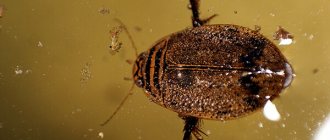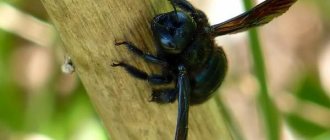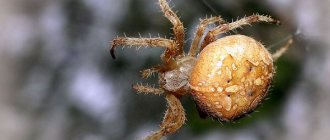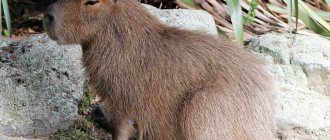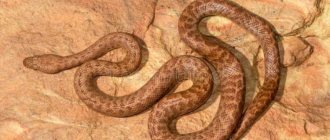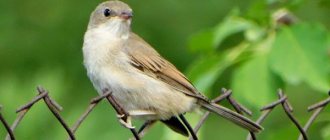Description and features
More than 40 thousand species of this beetle are known in the world. More than three thousand species are observed on the territory of Russia. They belong to the same species, but have significant differences among themselves: in color, size, and sometimes in external structure.
As a rule, the color of beetles is dark, with a bright metallic tint. This is especially noticeable in the sun. The tide can be greenish, blue, or golden. Red and ginger shades are less common.
If you look closely at the metal cast, you can see that it consists of many thin strips. It will be difficult for an inexperienced person to distinguish beetles from each other, but a few simple descriptions will help to identify a beetle of the ground beetle family from ordinary insects.
So:
- ground beetle is a large insect, some species can reach ten centimeters in length; body oval;
- upon a detailed examination of the beetle’s body, one can clearly see the head, separated from the body by a movable neck section, as well as massive jaws;
- the beetle has high, long legs, consisting of several segments; such paws are perfectly adapted for running on various surfaces, so catching an insect can be difficult;
- long mustaches protruding several centimeters forward, covered with bristles; the whiskers serve as a radar for the ground beetle;
- The front legs are equipped with peculiar serrations that serve as a brush for the insect to clean its jaws.
The ground beetle has strong wings, the size of which depends on its habitat. In regions with sufficient food, the wings are rather poorly developed, since there is no need to travel a long distance in search of food. The wings are rarely used for dispersal, and when unnecessary, they often grow together.
A distinctive feature of the metal pest is its choice of habitat. They prefer areas with high humidity and stable high temperatures. That is why the ground beetle can most often be found in the southern part of Russia, Ukraine and Moldova.
Types of ground beetles
In Russia, the largest common species can be safely called the Caucasian ground beetle . They live in the northern regions of the Caucasus, mainly in mountainous areas. But you can also find them in the Krasnodar region. Don’t be afraid of an incomprehensible rustling sound while sitting in the garden with a cup of tea in your hands.
These beetles had a good rest during the day and rushed into battle at dusk. At night, beetles intensify their activity, begin to hunt for worms and small midges, and do not disdain larvae. The favorite habitats of ground beetles are gardens and parks, where you can safely hunt and there is no shortage of food.
The Caucasian ground beetle can be recognized at first glance by its bright bluish, sometimes greenish and purple color. It is noteworthy that this particular species of beetle is listed in the Red Book of the Russian Federation as rapidly declining. Back in the 19th century, scientists actively hunted for beautiful beetles to add to their personal collection or to sell to less fortunate colleagues not only in Russia, but also abroad.
It will be a rare success to discover another species of ground beetle - the Crimean one. Its name speaks for itself. You can find it within the Crimean peninsula, mostly in the southwestern part. However, just the desire to get an insect is not enough. You need to be patient and have a powerful flashlight, because this beetle is a nocturnal creature and goes out hunting only after sunset.
The Crimean ground beetle is a rather large beetle. Cases have been recorded when its body length reached 6 centimeters. Due to its size and hunting talent, the beetle is a dangerous enemy not only for small insects, but also for small lizards. He loves grape snails, so you can also find him near water, in small backwaters.
Carefully! This type of beetle can also be dangerous for humans. The fact is that in the back of the body the Crimean ground beetle has special glands that contain a caustic liquid. This is not poison, but the composition of the liquid is aimed at scaring away enemies. The beetle shoots this liquid towards the threat.
The length of the shot can reach two meters and can easily hit, for example, the eyes. If this happens, you should immediately rinse your eyes or any other affected area with plenty of water and seek medical attention. There is no point in taking revenge on the beetle. This ground beetle is listed in the Red Book as an endangered species.
The beautiful ground beetle is the most pretentious representative of its species. Its full name is fragrant krasotel. Its average size varies from 3 to 4 centimeters. The body of the insect, like its fellows, has a metallic sheen, but unlike other species it has a magnificent color.
Most often these are blue-green shades interspersed with gold and copper. He prefers to settle in coniferous and deciduous forests, in parks and gardens, where it is humid and nourishing thanks to the colonies of butterflies and caterpillars living there. It is these that the handsome beetle hunts on dark nights.
Most often you can find the beauty in the forests of European countries, Moldova, Belarus, Georgia, and a number of countries in Central Asia. The ground beetle is a rare insect, listed in the Red Book not only of Russia, but also of Europe.
The more common types of ground beetles are:
- shagreen;
- garden;
- granivores;
- horses;
- lebia.
It is these types of insects that are widespread in all regions of Russia.
Effect of poison
Many experts still cannot say for sure whether the ground beetle is considered poisonous or not. Some types of ground beetles, when threatened, shoot caustic liquid at a distance of up to half a meter. The venom of these beetles contains formic acid, which can cause severe burns to the skin and mucous membranes.
If such poison gets on a person’s skin, severe swelling may occur that does not go away for several days. If beetle venom gets on the skin, it is necessary to wash the affected area with a large volume of water. If swelling has already occurred, the person needs to take antihistamines. Swelling of the face and neck is especially dangerous, as this can lead to suffocation.
If toxic liquid gets into the eyes, severe irritation of the mucous membrane occurs, which can lead to conjunctivitis. In this case, it is advisable for the victim to see an ophthalmologist.
To prevent the proliferation of ground beetles in your home, it is necessary to store all cereals in hermetically sealed containers.
Lifestyle and habitat
All types of ground beetles are considered terrestrial insects. Most often, they make their home under stones, between tree roots, among foliage and in thickets of grass. Only a few species of insects are able to build their homes in trees, and then only low, at a height of up to two meters.
Despite the fact that beetles are predators, they themselves can easily become prey for birds, so they make their shelters in crevices of the bark or between branches. The main living conditions are high humidity, stable temperature conditions and dense shade.
Recent observations of these beetles have finally convinced scientists that ground beetles live in several families. Small groups of insects allow them to successfully hunt larger prey, such as small lizards.
The beetles' lifestyle is predominantly nocturnal. At night, all active members of the family go hunting, and with the first rays of the sun they go into the shade until the evening. Some representatives of ground beetles prefer to be active during the day and “rest” in their shelter at night.
With the onset of cold weather, around mid-October, the beetles burrow deep enough into the ground and hibernate, so that with the onset of the first warm spring days they can continue their lives again.
Nutrition
The ground beetle lives in forests, parks, gardens and personal plots, where there is a large accumulation of all kinds of food. The favorite “dishes” of beetles were and remain:
- caterpillars;
- larvae;
- aphid;
- slugs;
- snails
The principle of hunting and capturing prey is extremely simple. When a beetle discovers its “dinner,” a special fluid is activated in the glands hidden in its powerful jaws. The beetle sprays its victim with this composition, waits a few minutes and then begins to eat.
The injected composition immobilizes the insect and softens it into a kind of pulp, which the beetle easily absorbs. After a hearty lunch, the ground beetle can return to its shelter and not come out for several days in a row to digest the food. After complete digestion, after two or three days, the beetle goes hunting again.
Some species, such as amara and ophorus, prefer exclusively plant foods. Their diet includes leaves and soft parts of plants. Such beetles can harm crop plants.
About pests
Some types of ground beetles are pests. Damaging cultivated plantings, they pose a serious threat to vegetable gardens and agricultural farms. Thus, the harmful group includes the bread ground beetle - a black resinous individual, the body length of which does not exceed 1.5 cm. Answering the question of what ground beetles of this species feed, we note that Their main delicacy is cereals.
On a note!
Giving preference to cereal crops, pests destroy huge areas of crops. They eat young leaves of winter crops, which prevents further plant growth. Their favorite delicacy is nectar and pollen.
Beetle larvae also cause no less harm when they feed on the milky juice of young grain. Wheat, rye and barley fields are especially affected by pests. They will not refuse corn and oats. Even leeks can replace the lack of cultural plantings.
Bread ground beetle
After mating, females lay eggs (there can be up to 250 of them in one clutch), which are white in color, smooth surface and oval in shape. After three weeks, larvae emerge from them. They live in the upper layer of soil and feed on the leaves of various cereal crops. In the winter season, the larvae go to live underground, most often on winter crops. By mid-spring they pupate, which takes about 20 days. After which they become sexually mature individuals.
Reproduction and lifespan
It is generally accepted that insects live for one season. Many - yes, but not the ground beetle. Among insects, this is a long-lived beetle. Its average lifespan is about three years. Under good living conditions, beetles can live for four to five years. Before becoming an adult, the beetle goes through four stages:
- egg;
- larva;
- chrysalis;
- bug.
The mating season for ground beetles occurs at the end of April - beginning of May. One clutch of a female contains about 70-80 eggs. There are special requirements for the masonry site. It should be very humid, warm and dark. The land must be fertile, as people say – “fat”. The female lays eggs in the ground to a depth of about three centimeters.
It takes approximately two weeks for the eggs to develop into larvae. The ground beetle larva reaches quite large sizes, about 2 centimeters. In the first hours the larvae are white, then within 24 hours each becomes black.
In its larval form, the ground beetle lives until the end of summer according to the same laws as adult beetles. The larva already has powerful jaws with which it grabs the victim, sprays it with a specific liquid and eats it.
After consuming food, the larva can also go into the ground for several days until it is completely digested. At the end of summer, the larva in its shelter becomes covered with a cocoon and falls asleep. The appearance of a full-fledged beetle occurs only in the spring.
Natural enemies
In their natural environment, ground beetles are forced to fight several types of enemies:
- parasites, which include fungi, and even some specific forms that live on eggs and adult adults.
The ground beetle's body (intestines, mouthparts, wings) contains many forms of organisms that can cause a variety of problems - from parasitic castration to the death of the beetle.
Such parasites also include nematodes and mites: for example, one beetle can contain several types of very different parasites, which are favored by various parts of the beetle’s body. Ground beetle larvae are especially attractive to wasps and flies, which thus breed their offspring.
- Predators: hedgehogs, moles, foxes, bats, birds, reptiles and amphibians.
This is the most important factor that helps regulate the number of this type of insect.
The hedgehog is a natural enemy of ground beetles
The benefits and harms of ground beetles for humans
Ground beetles can be divided into two groups: harmful and beneficial. One of the dangerous species is the ground beetle. It belongs to the so-called category of poisonous beetles.
But poisonous not in the literal sense of the word. Its poison is a caustic chemical compound that is not capable of killing a person, but can cause allergic reactions in the form of rashes and swelling. A burn from such poison can last on the skin for about three days.
The ground beetle can cause serious damage to plants and damage household utensils and furniture. Thanks to its powerful jaws, the beetle can grind very hard material. The beetle causes serious damage to cereal plants, spoils indoor flowers by gnawing on roots, and easily reaches vegetable and berry crops.
This ground beetle is a nocturnal resident, so under the cover of darkness, while the owner is sleeping, it can climb onto bags of cereal, making holes in them. They easily allow themselves to climb onto the table in search of crumbs of food, without fear, they can crawl onto a person.
If such a beetle is found in the house - and you can recognize it by its characteristic dark purple color - you should immediately take action. To destroy the pest, modern chemicals are used, which can be purchased at any disinfection store. If you do not start fighting the beetle in time, its number can grow significantly, and then it will be much more difficult to get rid of uninvited residents.
But there are also positive aspects. Some types of beetles stand guard over the garden. These are the beauties, the Crimean ground beetle and the “tiger”. The favorite food of the Crimean ground beetle is the grape snail. This pest causes irreparable harm to grape crops and berries, spoils already ripe fruits, undermines the roots, which cannot recover and the plant dies.
Summer residents and gardeners are happy to see Krasotelov on their plots. It is thanks to the predatory skills of this beetle that the garden plots and crops are in perfect order. The beetle destroys all kinds of harmful pupae and insect larvae. Interestingly, ground beetle larvae are also hunters.
Due to their small size, they are not capable of destroying large insects, but they cope with small ones with a bang. Another interesting specimen is the tiger ground beetle. It is named so because the structure of its jaws resembles a tiger’s mouth with sharp, huge fangs.
With them he tears apart his prey. Insects that fall into the jaws of this beetle are doomed to death. The beetle lives in grass and between clods of earth. It is in constant search of food, so once you see it on your site, you can be calm about the safety of the harvest.
How a beetle gets into a home
Such a harmful insect as the ground beetle can live not only in fields, gardens and vegetable gardens. Often these predators penetrate human habitation. The main routes of insect penetration are:
- With wood, for example, with old furniture. In addition, the larvae can be carried in with street dust.
- If you keep hamsters as pets at home, the food may attract such insects.
- Bugs can fly into the house if there is no mosquito net on the windows.
- These bugs love to live in old wooden window sills, antique furniture and wooden frames.
- Sometimes ground beetles settle in stocks of potatoes, flour and various cereals.
The ground beetle is not poisonous to humans. The insect secretes a caustic substance that irritates the skin. If secretions from the ground beetle's abdomen get into the eyes, rapid conjunctivitis may develop.
When a person is bitten by a ground beetle, severe swelling may occur that does not go away for several days. This is due to an allergic reaction.
